Click on images to enlarge

infestation along a waterway (Photo: Sheldon Navie)
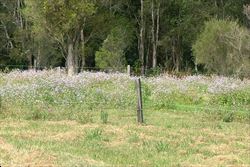
large infestation in a pasture (Photo: Sheldon Navie)
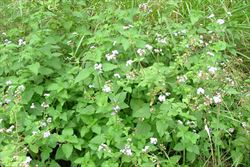
habit (Photo: Sheldon Navie)
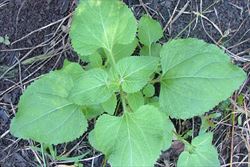
paired lower leaves with slightly heart-shaped bases (Photo: Sheldon Navie)
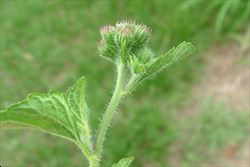
close-up of hairy stems, alternately arranged upper leaves, and young flower-heads with hairy bracts (Photo: Sheldon Navie)

branched clusters of flower-heads at the tips of the stems (Photo: Sheldon Navie)
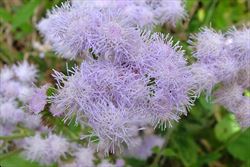
close-up of flower-heads showing their long floral projections (Photo: Sheldon Navie)

plants with white flower-heads are occasionally seen (Photo: Sheldon Navie)
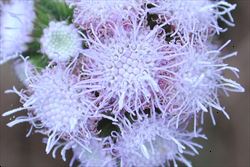
close-up showing the numerous tiny flowers in each flower-head (Photo: Sheldon Navie)
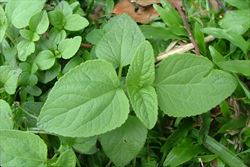
young plant and seedlings (Photo: Sheldon Navie)

comparison of billygoat weed (Ageratum conyzoides), with sparsely hairy bracts and short floral projections on the left, and blue billygoat weed (Ageratum houstonianum), with very hairy bracts and long floral projections on the right (Photo: Sheldon Navie)
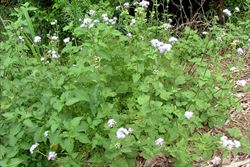
habit (Photo: Sheldon Navie)

old flower-heads and 'seeds' (Photo: Sheldon Navie)

close-up of persistent flower-head bracts (Photo: Sheldon Navie)
Scientific Name
Ageratum houstonianum Mill.
Synonyms
Ageratum mexicanum Sims
Family
Asteraceae (Queensland, New South Wales, the ACT, Victoria, Tasmania, Western Australia and the Northern Territory)Compositae (South Australia)
Common Names
ageratum, billy goat crofton, billy goat weed, billygoat weed, blue billy goat weed, blue billygoat weed, blue top, bluemink, bluetop, dark bluetop, floss flower, flossflower, garden ageratum, goat weed, goatweed, invading ageratum, Mexican ageratum, Todd's curse, tropic ageratum
Origin
Native to Mexico, Central America and the Caribbean.
Cultivation
Blue billygoat weed (Ageratum houstonianum) has been widely cultivated as a garden ornamental, and in cultivation it is often known as "floss flower". There are many different cultivars, which vary in size and flower colour (i.e. blue, purple, pink and white flowered cultivars are available).
Naturalised Distribution
This species is widely naturalised in the coastal districts of eastern Australia (i.e. in eastern Queensland and eastern New South Wales).
Also widely naturalised in the tropical regions of the world, including south-eastern USA (i.e. Florida, Alabama, Georgia, South Carolina and North Carolina) and some Pacific islands (e.g. Hawaii, Fiji and French Polynesia).
Habitat
A weed of gardens, roadsides, disturbed sites, waste areas, pastures, crops, wetlands and waterways in the tropical, sub-tropical and warmer temperate regions of Australia.
Habit
A short-lived (i.e. annual or biennial) herbaceous plant growing 0.3-1 m tall.
Distinguishing Features
- a short-lived herbaceous plant with softly hairy stems and leaves.
- its toothed leaves are oppositely arranged at the base of the stems, but are often alternately arranged at the top of the stems.
- its flower-heads are usually blue (occasionally pink or whitish) and lack any obvious 'petals'.
- these flower-heads have very hairy bracts and numerous long narrow projections.
- its tiny black or brown 'seeds' (about 2 mm long) are topped with five whitish, hair-like, scales.
Stems and Leaves
The stems are round, mostly green in colour, and softly hairy (i.e. pubescent).
The leaves are mostly oppositely arranged, but can be alternately arranged on the upper parts of the stems. They are borne on stalks (i.e. petioles) 0.5-3 cm long and vary from being almost triangular in shape to egg-shaped in outline (i.e. ovate). These leaves (2-7 cm long and 1.5-6 cm wide) have bluntly toothed (i.e. crenate) margins and either blunt or pointed tips (i.e. obtuse to acute apices). Both surfaces of the leaves and the leaf stalks have a scattered covering of hairs (i.e. they are pubescent).
Flowers and Fruit
The flower-heads (i.e. capitula) are arranged in dense clusters at the tips of the branches (i.e. in terminal corymbs) and do not have any obvious 'petals' (i.e. ray florets). Each flower-head (5-8 mm across) has numerous tiny tubular flowers (i.e. tubular florets) that are surrounded by two or three rows of greenish-coloured bracts (i.e. an involucre). The florets (2-3 mm long) range from pale lavender to blue, pink or purplish in colour and each has two elongated projections (i.e. style branches). The bracts at the base of the flower-head (3-5 mm long) are elongated in shape (i.e. linear-lanceolate) and covered in sticky hairs (i.e. glandular pubescent). Flowering occurs throughout most of the year.
The 'seeds' (i.e. achenes) are about 2 mm long, brown to black in colour, and topped with five awn-tipped scales (i.e. a pappus). These scales (2-3 mm long) are whitish in colour and resemble short bristles or hairs.
Reproduction and Dispersal
This species reproduces by seed. The tiny, light, seeds are often dispersed by wind and water. They readily become attached to animals, clothing and vehicles and may also be spread in contaminated agricultural produce.
Environmental Impact
Blue billygoat weed (Ageratum houstonianum) is regarded as an environmental weed in Queensland and New South Wales. This garden escape frequently invades bushland and other natural environments resulting in substantial changes in native plant communities. It displaces indigenous plants, and possibly also native animals, and is particularly invasive along waterways and in riparian vegetation.
In Queensland, blue billygoat weed (Ageratum houstonianum) is currently of most concern in the south-eastern parts of the state, where it is ranked among the top 200 environmental weed species. It is listed as an environmental weed in numerous local authorities in this region (e.g. in Redland Shire, Maroochy Shire, Cooloola Shire, Caboolture Shire, Burnett Shire, Hervey Bay City and Maryborough City) and also invades conservation areas. For example, blue billygoat weed (Ageratum houstonianum) is one of only a few introduced species that have colonised undisturbed or relatively intact open forest vegetation within Brisbane Forest Park.
In New South Wales, blue billygoat weed (Ageratum houstonianum) is primarily of concern in the central and northern coastal regions. It appears on the "Bushland Friendly Nursery Scheme" list of environmental weeds for north-eastern New South Wales and on several local weed lists in this region (i.e. in Byron Shire, Lismore City and Coffs Harbour City). It also appears on local and regional environmental weed lists further south (i.e. in Pittwater Shire, Hornsby Shire, Wyong Shire, Gosford City, the Central Coast region, the north Sydney region and the wider Sydney and Blue Mountains region). Blue billygoat weed (Ageratum houstonianum) also forms dense patches on coastal hinddunes and headlands in New South Wales and has also been recorded in conservation areas in various parts of the state (e.g. in the Munro Island Nature Reserve in northern New South Wales and the McKay Reserve in Sydney).
Blue billygoat weed (Ageratum houstonianum) is also considered to be among the most invasive species in southern Africa, and is thought to pose a threat to the biodiversity of this region. It is one of several closely-related species that are invading savannas, grasslands, forest margins, riverbanks and wetlands in South Africa and neighbouring countries (i.e. Swaziland, Mozambique and Zimbabwe). It often forms dense stands that exclude other species and there is evidence to suggest that it has allelopathic properties that inhibit the growth and germination of other plants.
Other Impacts
This species is a very common weed of sugar cane crops in Queensland, and is also a weed other cropping systems in the coastal areas of southern and central Queensland.
Legislation
This species is not declared or considered noxious by any state or territory government in Australia.
Similar Species
Blue billygoat weed (Ageratum houstonianum) is often confused with another very similar species, billygoat weed (Ageratum conyzoides). These species can be distinguished by the following differences:
- blue billygoat weed (Ageratum houstonianum) has numerous sticky hairs on the bracts surrounding its flower-heads (i.e. the involucral bracts are glandular pubescent). Each of the tiny flowers (i.e. florets) which make up the flower-heads have two short and narrow projections (i.e. style branches) that are about 1-2 mm long. The bases of the flower-heads are relatively small (3-6 mm across).
- billygoat weed (Ageratum conyzoides) has only a few hairs on the bracts surrounding its flower-heads (i.e. the involucral bracts are glabrous or sparsely pubescent). Each of the tiny flowers (i.e. florets) which make up the flower-heads have two long and narrow projections (i.e. style branches) that are about 5 mm long. The bases of the flower-heads are relatively large (5-8 mm across).
Another environmental weed, praxelis (Praxelis clematidea), and a native plant, vernonia (Cyanthillium cinereum), are also very similar to blue billygoat weed (Ageratum houstonianum). However, praxelis (Praxelis clematidea) leaves have deeply toothed (i.e. coarsely dentate) margins and the bracts surrounding each flower-head (i.e. involucral bracts) fall off when the seeds are shed (i.e. they are deciduous). Vernonia (Cyanthillium cinereum) leaves have finely-toothed (i.e. crenate) or almost entire margins and the seeds are topped with about 20 relatively large bristles (4-5 mm long).

